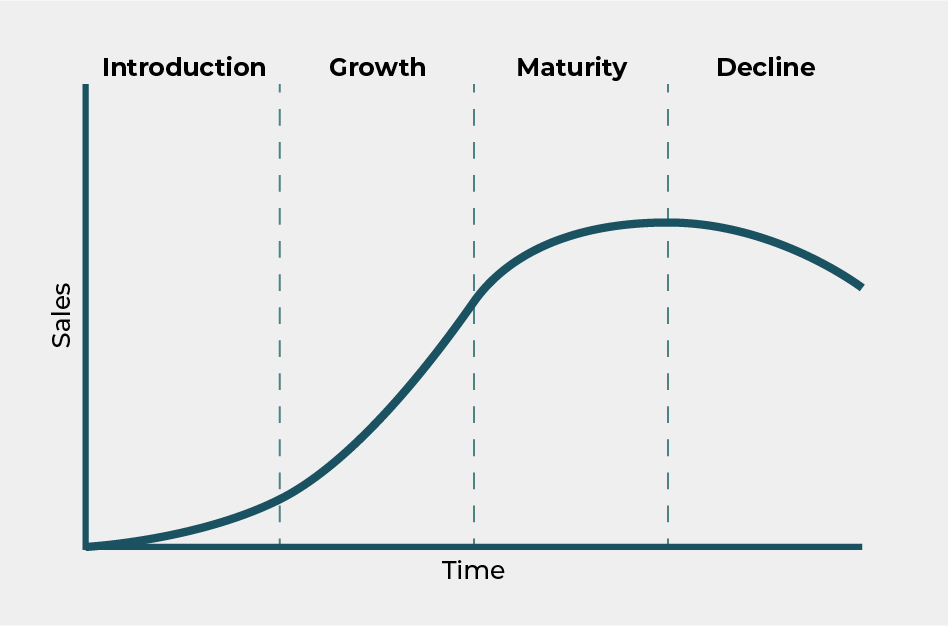4.4 Product Life Cycle
The product life cycle (PLC) describes the series of stages that a product goes through from its initial introduction to the market until its eventual withdrawal or discontinuation. Each product follows its own unique life cycle, which is influenced by its characteristics, market conditions, and consumer preferences. Figure 4.4.1 illustrates the typical stages of a product life cycle.

No product can satisfy consumer needs and wants indefinitely. The longevity of a product in the market depends on its ability to meet evolving customer expectations and adapt to changing market dynamics. As a result, both sales and profits associated with a product fluctuate over time.
Understanding the product life cycle is essential for businesses, as it highlights the relationship between sales volume and profitability throughout the product’s existence. The PLC framework shows key moments in a product’s journey: its introduction to the market, the phase of rapid growth and acceptance, the peak of its success, the period of decline, and finally, its exit from the market.
The main stages of the product life cycle are explained in detail in the following section.
Stages of the Product Life Cycle
The product life cycle (PLC) consists of four main stages: Introduction, Growth, Maturity, and Decline. Each stage presents unique challenges and opportunities for marketers and requires distinct strategies for success.
Introduction Stage
The introduction stage begins when a new product is launched and becomes available to consumers for the first time. At this point, consumer awareness is low, and there is little to no prior experience with the product. Companies typically invest heavily in marketing and promotional activities to create awareness and stimulate interest. Distribution is often limited, and sales grow slowly as the market learns about the product.
Key characteristics of the introduction stage include:
- Significant investment in advertising and promotion to build product awareness.
- High costs related to development, production, and marketing, often resulting in losses or minimal profits.
- Limited competition, as few firms have entered the market.
- Low sales volume, with gradual growth as consumers begin to adopt the product.
- Pricing strategies may vary; some firms set higher prices to recover development costs, while others may use penetration pricing to attract customers.
- Technical and production challenges may arise and require attention.
Growth Stage
During the growth stage, the product gains market acceptance, and sales increase rapidly. Consumer awareness and demand rise, leading to higher profits. As the product’s success becomes evident, competitors are attracted to the market, intensifying competition.
Key characteristics of the growth stage include:
- Rapid increase in sales and profitability due to growing consumer acceptance.
- Entry of new competitors, resulting in heightened competition.
- Expansion of distribution networks to reach more customers.
- Potential price reductions to attract price-sensitive buyers and defend market share.
- Ongoing promotional efforts to differentiate the product and maintain momentum.
- Product improvements and the introduction of new features to address customer feedback.
- Entry into new market segments and distribution channels.
Maturity Stage
The maturity stage is marked by a slowdown in sales growth as the product reaches widespread market acceptance. The market becomes saturated, and competition is intense. Profits begin to decline due to price competition and increased marketing expenses.
Key characteristics of the maturity stage include:
- Sales continue to grow but at a decreasing rate, eventually stabilizing.
- Profits decline as competition intensifies and price wars emerge.
- Marginal competitors may exit the market.
- Emphasis shifts to customer retention and loyalty.
- Companies often modify the product, explore new markets, or adjust the marketing mix to sustain sales.
- The maturity stage can be further divided into phases: growth maturity (sales growth slows), stable maturity (sales plateau), and decline maturity (sales begin to fall).
Decline Stage
In the decline stage, sales and profits decrease as the product loses relevance or is replaced by newer innovations. Consumer preferences shift, and the market contracts. Companies must decide whether to withdraw the product, reduce costs, or attempt to revitalize it.
Key characteristics of the decline stage include:
- Rapid decline in sales and a sharper decline in profits.
- Firms may discontinue the product, reduce promotional expenses, or focus on profitable segments.
- Remaining competitors may exit the market, while some firms continue with minor product modifications.
- Resources are often shifted to newer, more promising products.
- Cost control becomes a priority to maintain any remaining profitability.
Understanding these stages helps businesses develop effective strategies for managing products throughout their life cycle, from introduction to eventual withdrawal.
Significance of the Product Life Cycle
Product life cycle (PLC) analysis is crucial for the long-term success and competitiveness of a firm’s products. By systematically evaluating which stage a product occupies within its life cycle, companies can gain valuable insights into the product’s current market position and overall health.
Effective PLC analysis enables firms to anticipate shifts in consumer preferences and identify emerging market trends. This awareness allows companies to proactively adapt their marketing strategies, adjust pricing, modify product features, or explore new distribution channels in response to changing market conditions.
Moreover, understanding the product life cycle helps organizations allocate resources more efficiently, plan for product updates or discontinuation, and develop strategies to extend the profitable life of their offerings. Ultimately, PLC analysis supports informed decision-making, enhances a firm’s ability to respond to market dynamics, and increases the likelihood of sustained success in competitive environments.
“8. New Product Development” from Operations Management by Sudhanshu Joshi is licensed under a Creative Commons Attribution-NonCommercial 4.0 International License, except where otherwise noted.—Modifications: Used sections 6-6.2; reworded; removed content from stages; added further content.

